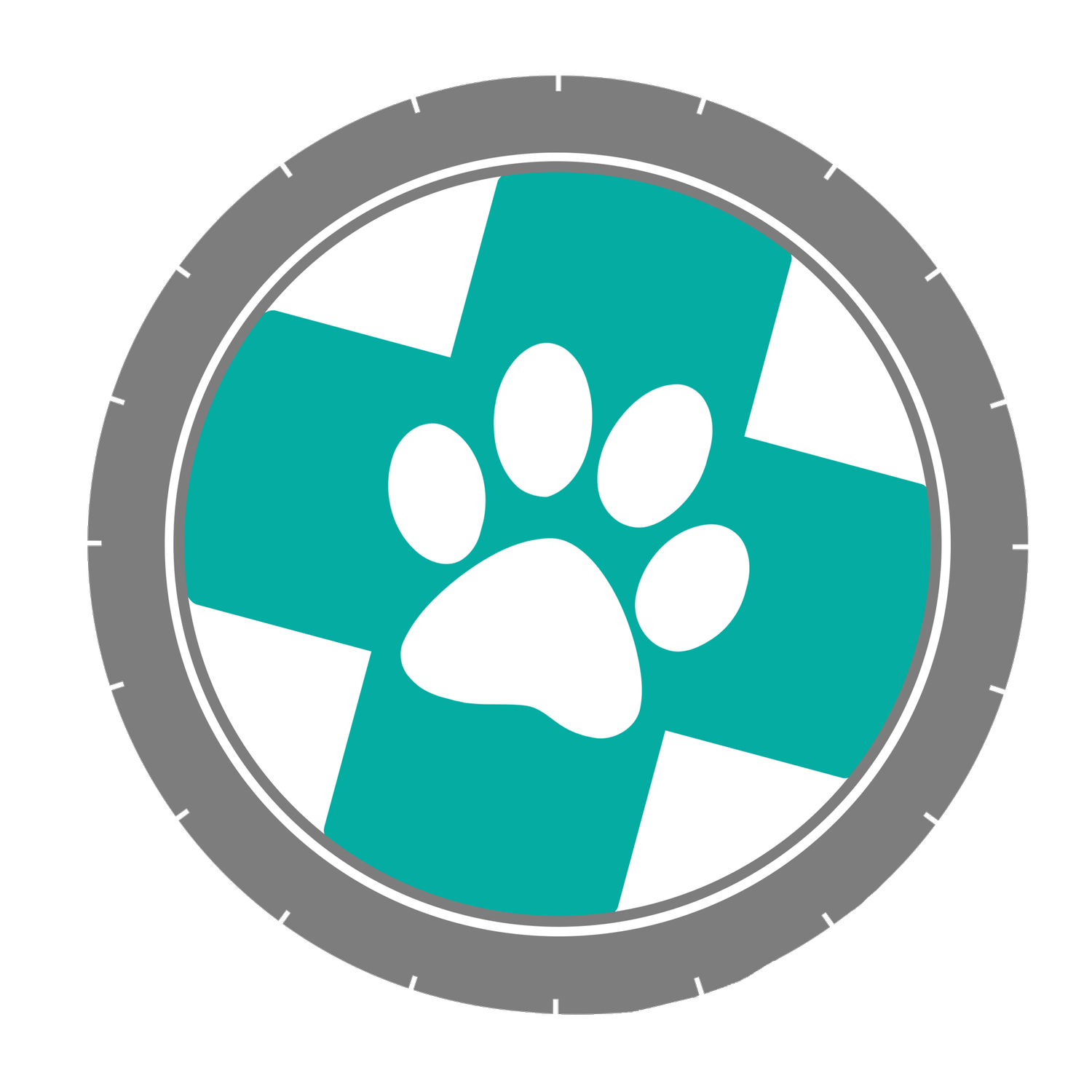Organic, Pure, Unfiltered Honey - Wound Care for 5,000 Years


What is it?
Introducing VetiHoney, the veterinary honey wound dressing that is revolutionizing pet care. Developed with the highest standards of veterinary medicine in mind, VetiHoney provides a natural and effective solution for treating wounds in animals. Its unique formulation harnesses the power of honey's antibacterial properties to accelerate healing and prevent infection in combination with the incredible anti-inflammatory herb turmeric. With VetiHoney, you can trust that your furry companion will receive the best possible care, ensuring their wounds heal quickly and painlessly. Say goodbye to traditional wound dressings and give your pet the therapeutic benefits of VetiHoney today.
Honey is collected from sustainable honey bee colonies from partner honey bee facilities. The honey is concentrated and then formulated into approximately 8g gel packs and formed into approximately 5cm x 5cm honey grafts. We are the only veterinary honey graft on the market with turmeric. No Upfront Payment Needed. We get paid when you get paid.
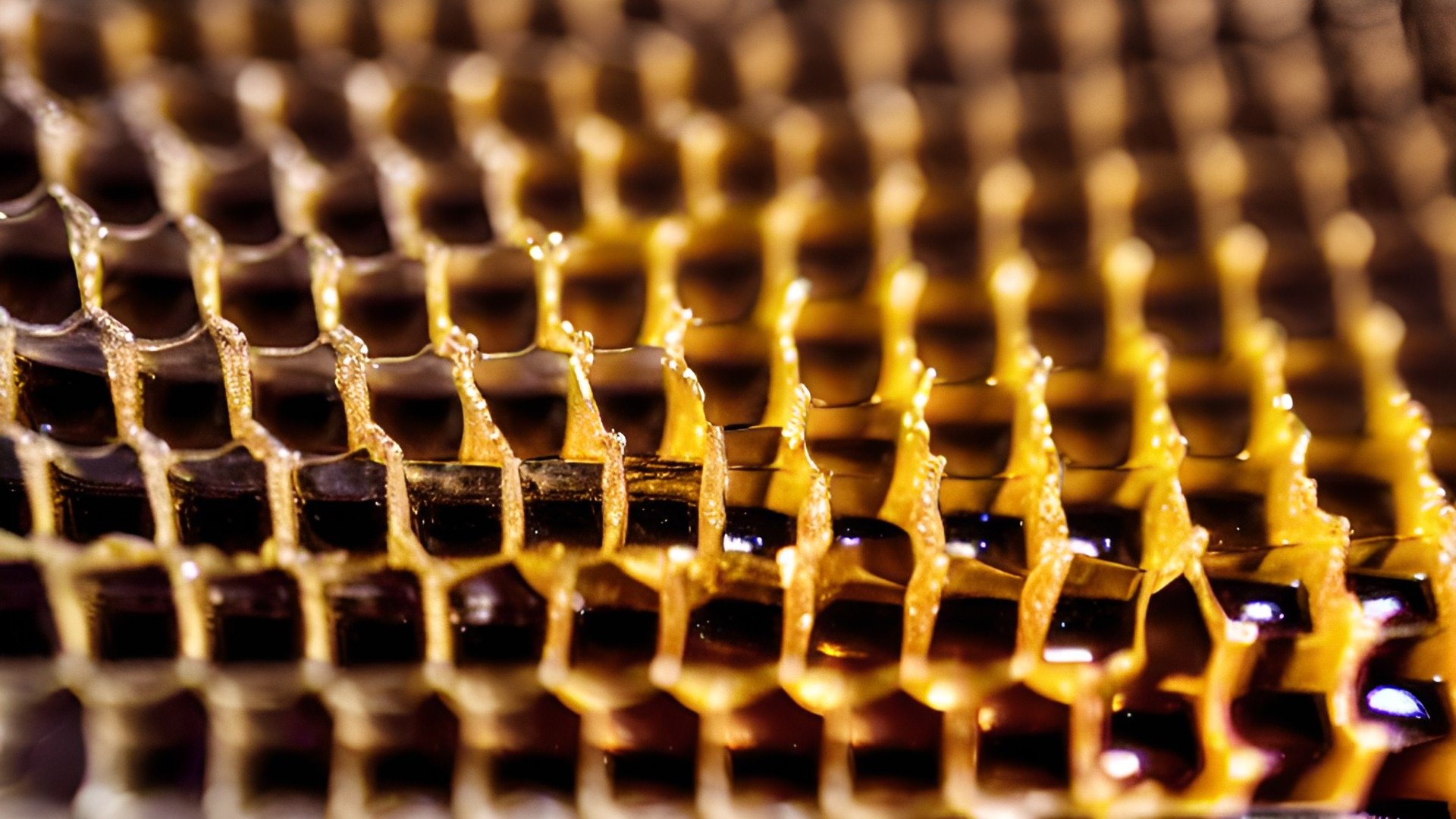
Ideal for simple wound dressing
6 year shelf life at room temp (heat if crystallization occurs, do not exceed 108F or healing enzymes will be destroyed)
All Species
Pack of 5: Approx. 8g Gel Packs
Ideal for complex wound dressing
6 year shelf life at room temp (heat if crystallization occurs, do not exceed 108F or healing enzymes will be destroyed)
All Species
Pack of 5: Approx. 5cm x 5cm Grafts

Ideal for sub-acute complex infection prone wound with accelerated healing.
6 year shelf life at room temp
All Species
Pack of 5: Approx. 5cm x 5cm Grafts
Ideal for complex infection prone wound with accelerated healing
6 year shelf life at room temp
Canine Only
Pack of 5: Approx. 5cm x 5cm Grafts
Ideal for complex infection prone wound with accelerated healing
6 year shelf life at room temp
Feline Only
Pack of 5: Approx. 2cm x 2cm Grafts
Ideal for complex infection prone wound with accelerated healing
6 year shelf life at room temp
Equine Only
Pack of 5: Approx. 5cm x 5cm Grafts

Acute Stage(1-4 days)
1st Choice: CyclaCanis, CyclaFelis, CyclaEqui
2nd Choice: CyclaGraft
Sub-Acute Stage(4-12 days)
1st Choice: CyclaGraft
2nd Choice: CyclaCanis, CyclaFelis, CyclaEqui
Chronic Stage(12+ days)
1st Choice: VetiHoney Graft
2nd Choice: CyclaGraft
Which Graft To Choose?
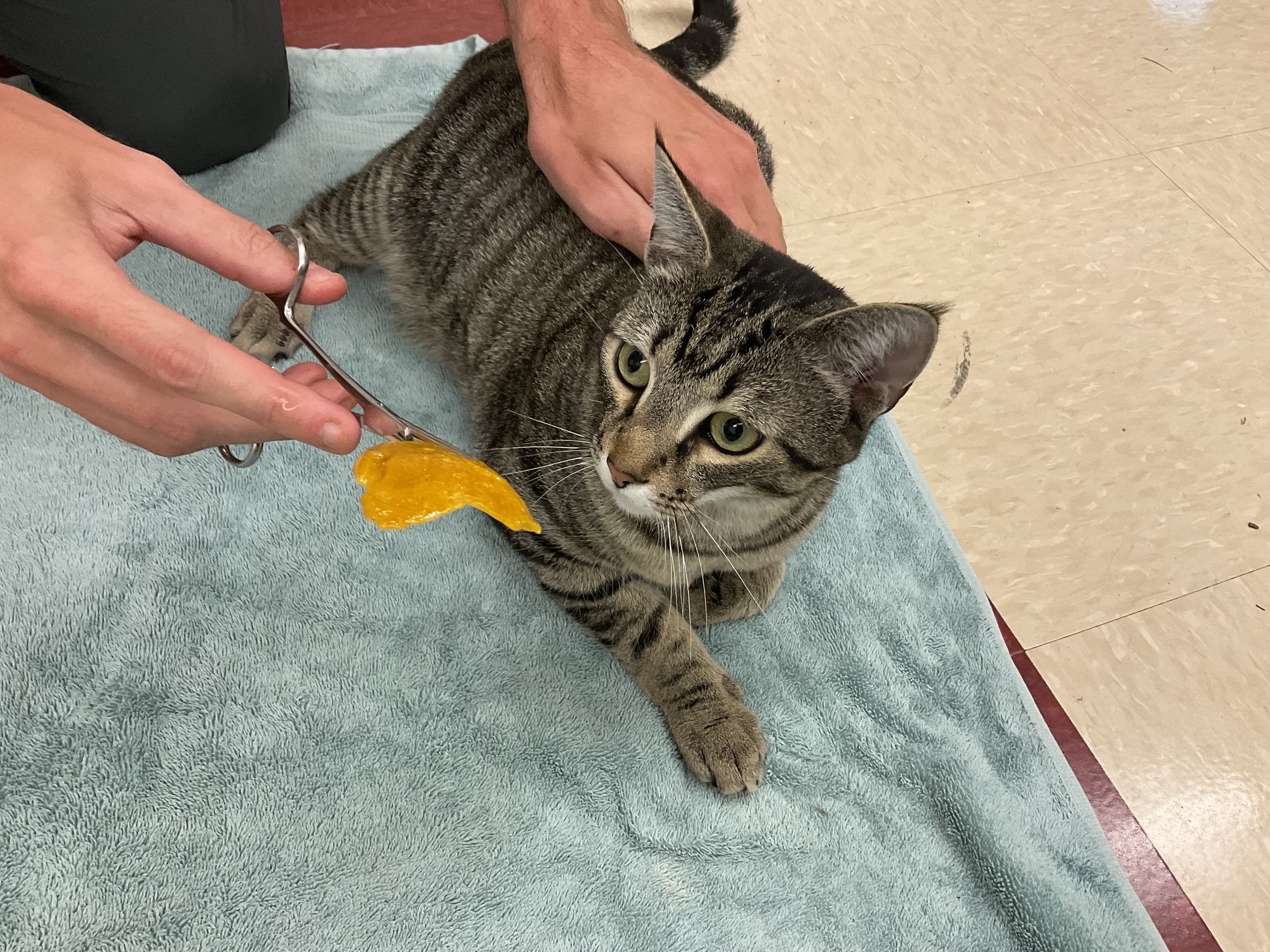
Graft or Gel?
VetiHoney grafts and gel are produced from the same honey and turmeric formulation. The honey undergoes several days of dehydration and freeze drying to remove as much water content as possible, maximizing the concentration of the honey and associated healing properties. Water removed from this process ranges from 50% total mass to as high as 80% total mass for VetiHoney Gel and VetiHoney Grafts respectively. VetiHoney grafts are best used for a more complex or deep wound, while VetiHoney gel can be used in combination with grafts or any other wound dressing to great effect.
Collagen Graft or Allograft?
Collagen is collected from grass fed pasture raised bovine and formulated into a collagen-honey matrix of 70% collagen and 30% concentrated honey. Collagen grafts can be used on any species, we recommend the same species tissue graft for the best results if funds are available and tissue grafts are in stock. If tissue is out of stock due to high demand, honey infused collagen grafts provide a great method for acute tissue trauma healing.
What’s in VetiHoney?
VetiHoney gel and grafts are produced from organic, pure, unfiltered honey using no sprays, pasteurization, additives, or preservatives. Your regular store bought honey has likely been pasteurized, nullifying a large amount of healing properties, as well as a huge water content diluting the honey. Our honey contains 27 minerals, 22 amino acids, and 5,000 enzymes as well as anti-viral, anti-bacterial, and anti-cancer effects. VetiHoney Gel and VetiHoney Grafts are both formulated with turmeric to provide additional regenerative, anti-microbial, anti-inflammatory, reduced healing times, and local cellular energy advantages compared to no other veterinary wound care products and is best used when granulation tissue is present. VetiHoney does not contain, nor has been treated with any chemical, detergent, carcinogen, antibiotic, fungicide, artificial coloring, preservative, or synthetic additive.
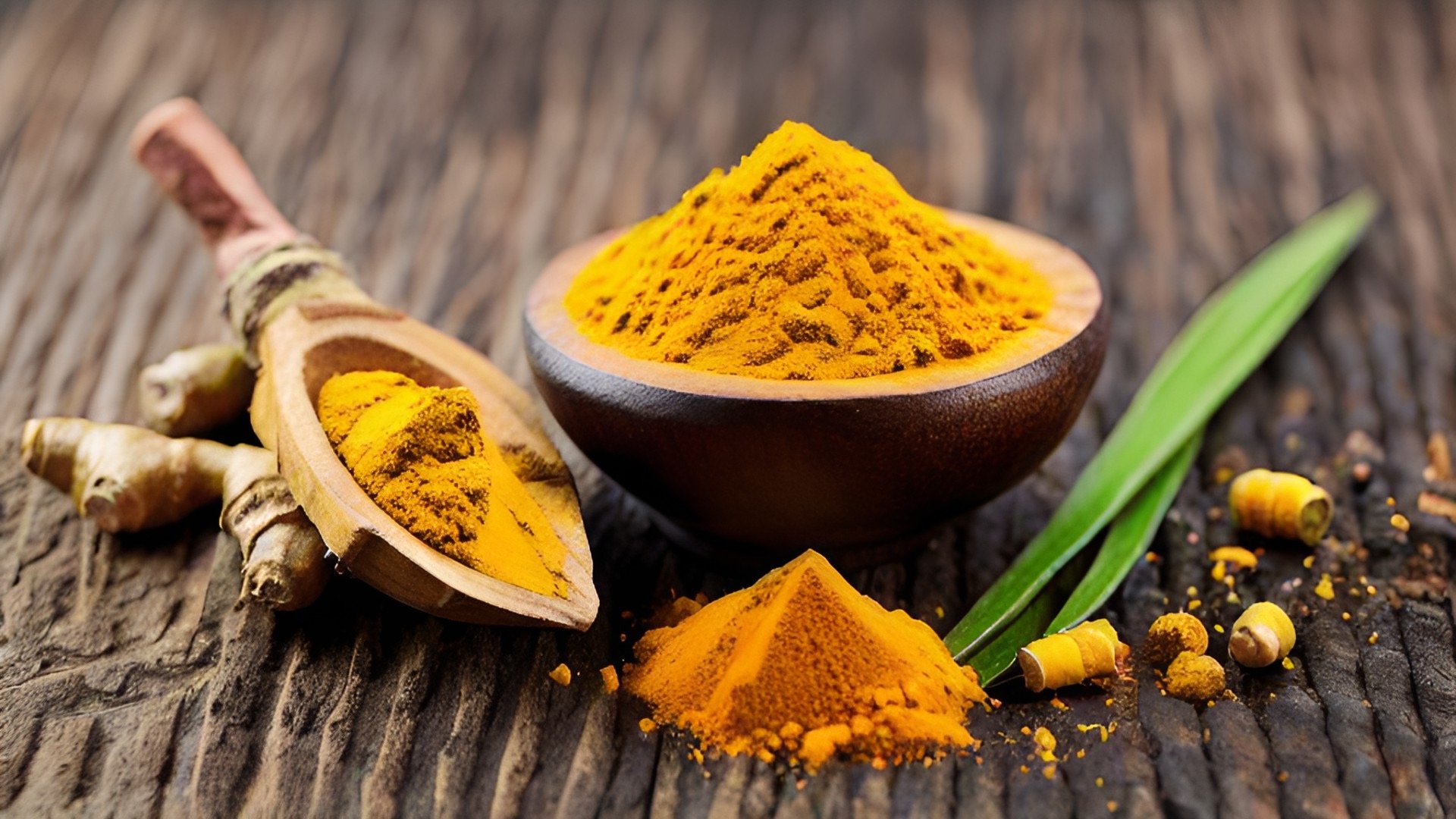
How is the product prepared for application?
Step 0. Choose the appropriate product for the wound.
Step 1. Using a sterile scalpel blade “freshen” or lightly scrape the wound and it’s periphery until a small amount of blood is seen emanating from the site.
Step 2. Remove the product from the plastic sealed sterile pack and cut the product to appropriate size of the wound.
Step 3. Place the product on the wound and allow it to adhere to the site.
Step 4. Gently apply sterile saline solution over the adhered product.
Step 5. Place an appropriate non-adherent 3 layer bandage over the site and repeat this graft process every bandage change (as deemed by veterinarian) until the wound is healed. For optimal results place a new allograft at each bandage change.
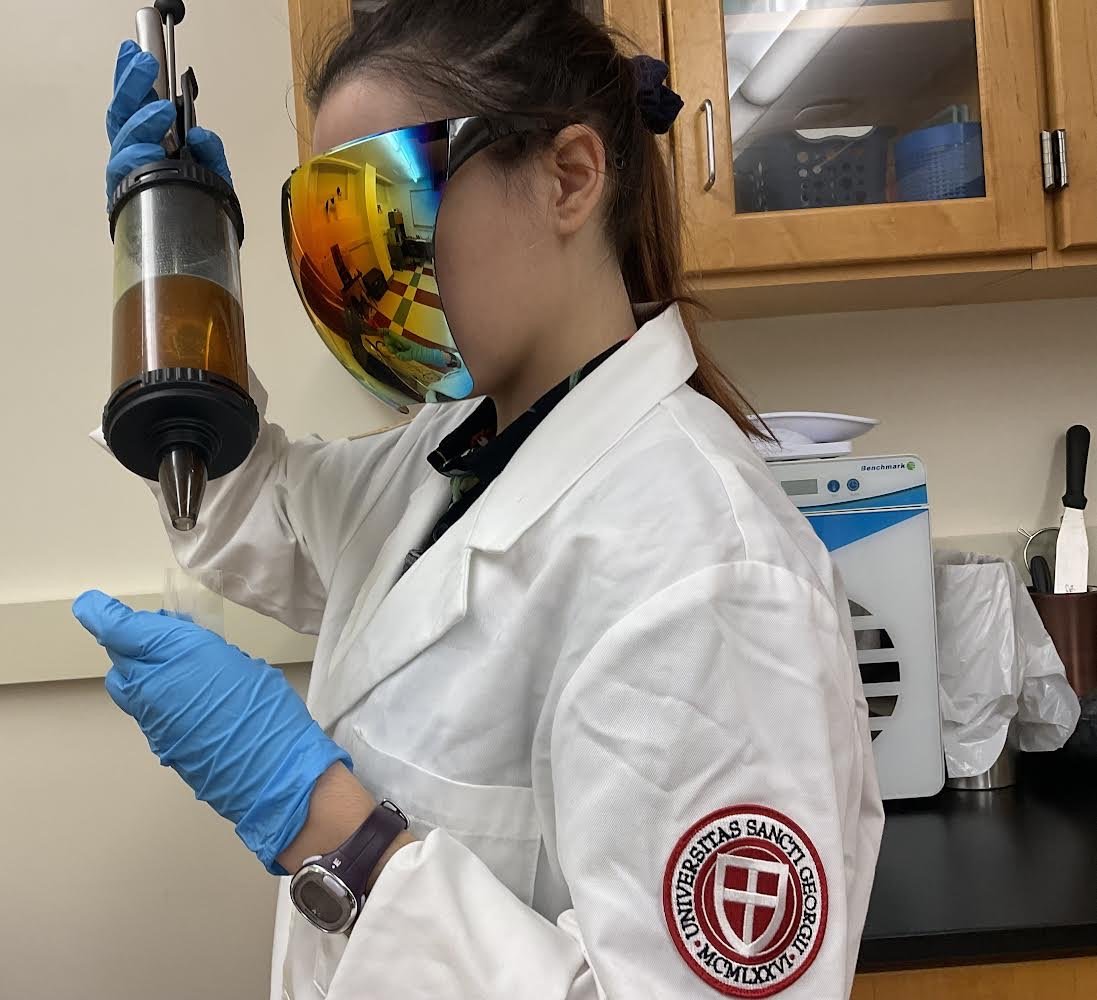
Evidence
Veterinary Wound Care Honey vs SSD Article (Free)
Veterinary Wound Care Collagen Article (Free)
“(Natural) honey treated wounds showed decreased inflammation, edema, and dehiscence and faster healing rate with faster formation of granulation tissue and fibroplasias.” - Hananeh et al., 2015
“Wounds of all patients reporting within 1 h of burns became sterile with the honey dressing in less than 7 days while there was none with SSD. All wounds treated with honey became sterile within 21 days while for SSD-treated wounds, this figure was 36.5%. A complete outcome was seen in 81% of all patients in the “honey group” while in only 37% patients in the SSD group.
Honey dressings make the wounds sterile in less time, enhance healing, and have a better outcome in terms of hypertropic scars and postburn contractures, as compared to SSD dressings.” - Gupta et al., 2011
“The sites treated with honey healed approximately 2 days sooner than the sites treated with SSD in all the patients. In fact, wound healing took less than 20 days in 93% of the sites treated with honey, but more than 24 days in the sites treated with SSD.
In honey group eight patients failed to heal, six patients' wounds got infected, two patients' wounds did not infect, but failed to heal otherwise. In SSD group 29 patients failed to heal. All of them got infected and fail to heal.” - Malik et al., 2010
“In general, turmeric extract gel at each concentration is effective against wound healing. Turmeric extract gel concentration is the most effective gel with a concentration of 5%, then followed by concentrations of 10% and 15%.
In this case, curcumin helps accelerate wound healing because curcumin is anti-inflammatory and antioxidant that can help speed up re-epithelization, cell proliferation, and collagen synthesis.” - Adeliana et al., 2021
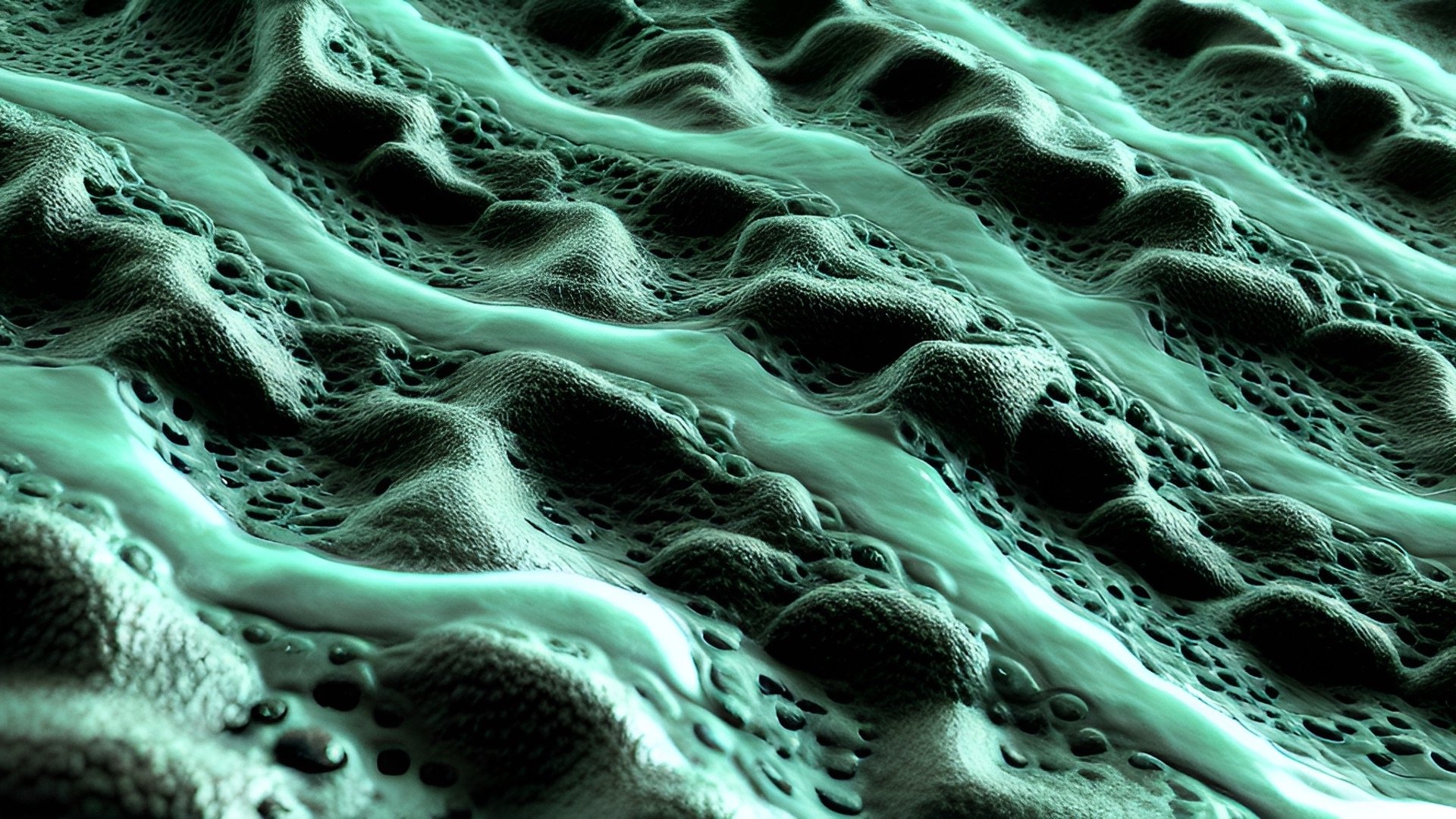
More Evidence!
“We demonstrated that SVFs had acceptable adherence on freeze-dried bovine amniotic membranes, showing that this complex can potentially be an effective scaffold with a high level of convenience for soft tissue engineering applications.” - Oh et al., 2021
“Skin Graft Market Size was valued at USD 4.00 Billion in 2022. The skin graft market industry is projected to grow from USD 4.28 Billion in 2023 to USD 7.36 Billion by 2032, exhibiting a compound annual growth rate (CAGR) of 7.01% during the forecast period (2023 - 2032).” - Gottadki et al., 2023
“According to the Healthcare Cost and Utilization Project, over 160,000 skin grafts are performed annually” - McDermott et al., 2018
- Agency for Healthcare Research and Quality
ROI Projections
Average Veterinary Wound treatment and repair is $800 - $2,500+
Average Veterinary Dog Bite Wounds is $1,000 - $10,000+
Average Veterinary Hit By Car is $1,000 - $8,000+
Average Veterinary Cat Bite Abscess is $500 - $2,000+
ER & Urgent Care Case Projections: over the past 5 years 38% - 200% increase in emergency and urgent care cases.
Average Animal Wound Heal Rates: 14 - 29 Days (depending on severity).
Average Grafts Needed per Animal Wound: 3 - 6 (new graft placed every bandage change 5-7 days).

Graft FAQs
-
We are currently commissioning research to be done at multiple veterinary universities in the United States. Ideally we want this to be done on horses, dogs, and cats to show a percentage better healing vs alternative treatment options. We will use thermal imaging to help quantify inflammation and healing.
-
Yes, providers will always have the option to pay up front however you can opt for paying the full price for the grafts within 30 days of the graft shipment leaving manufacturing facility. This is commonly done in human medicine and we have done and currently do this with human allograft sales.
-
We source all our tissue from reputable owned animals which have been evaluated by a licensed DVM at their respective facilities. We use tissue from live healthy animals including the uterus, amniotic membrane, placenta, naturally aborted animals, and young animals that died of natural non-infectious causes. Our tissue prepared using aseptic technique and terminally sterilized & packaged to last for 6 years.
Our collagen is sourced from grass fed and pasture raised bovine. Our honey is sourced from sustainable organic bee hive operations.
-
We are working to get exact numbers on how good our product is. We believe it is the new gold standard for veterinary wound care, especially when used with VetiHoney, TopoTherm, and ArthroPaws. Freeze dried grafts have been used to great effect in human medicine for many years and they can cost as much as $40,000 each. We are using the same technology but for a fraction of the cost and better healing properties with our honey infused option.
-
This is ultimately up to the licensed veterinarian on the case. Research and clinical evidence suggests at least 5-7 grafts are needed on average with one being used at each bandage change every 5-7 days. The optimal number is going to depend on the wound size, animal age, comorbidities, dirty/clean status, and many other factors.
How to Order?
Please reach out to our Chief Commercial Officer, Rachel Martin at info@vetxps.com
VetiHoney Flyer
VetiHoney Order Form
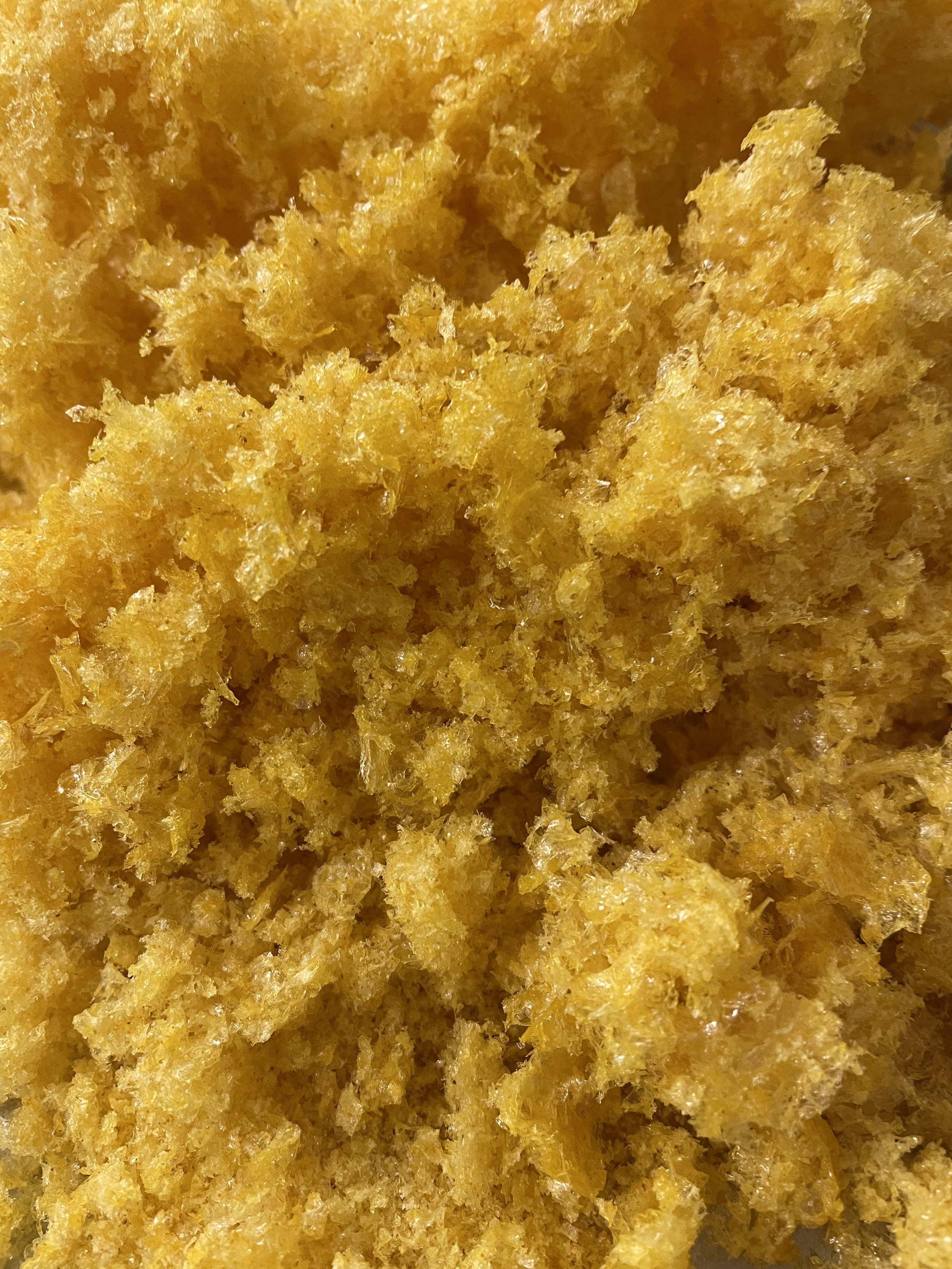
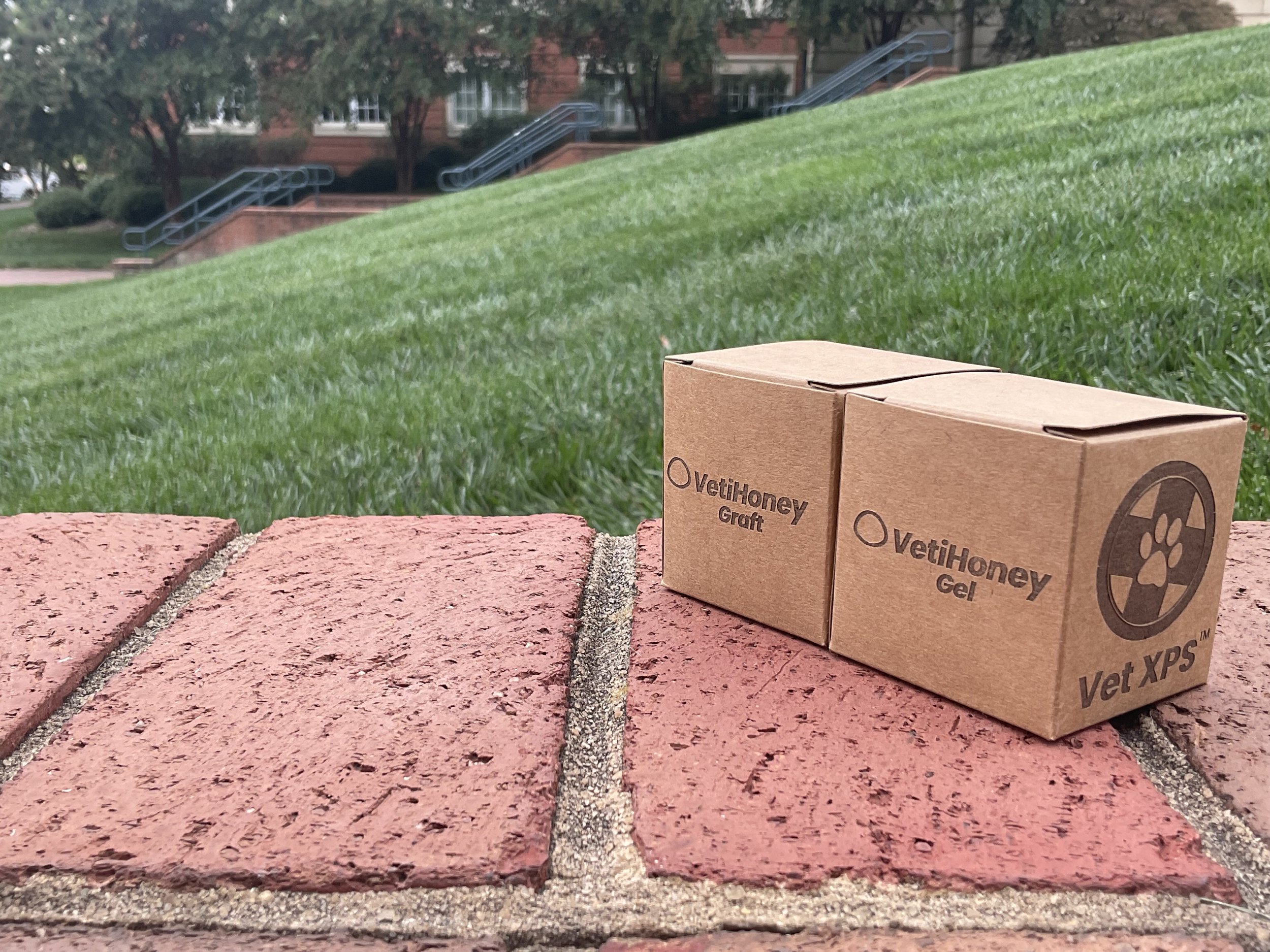
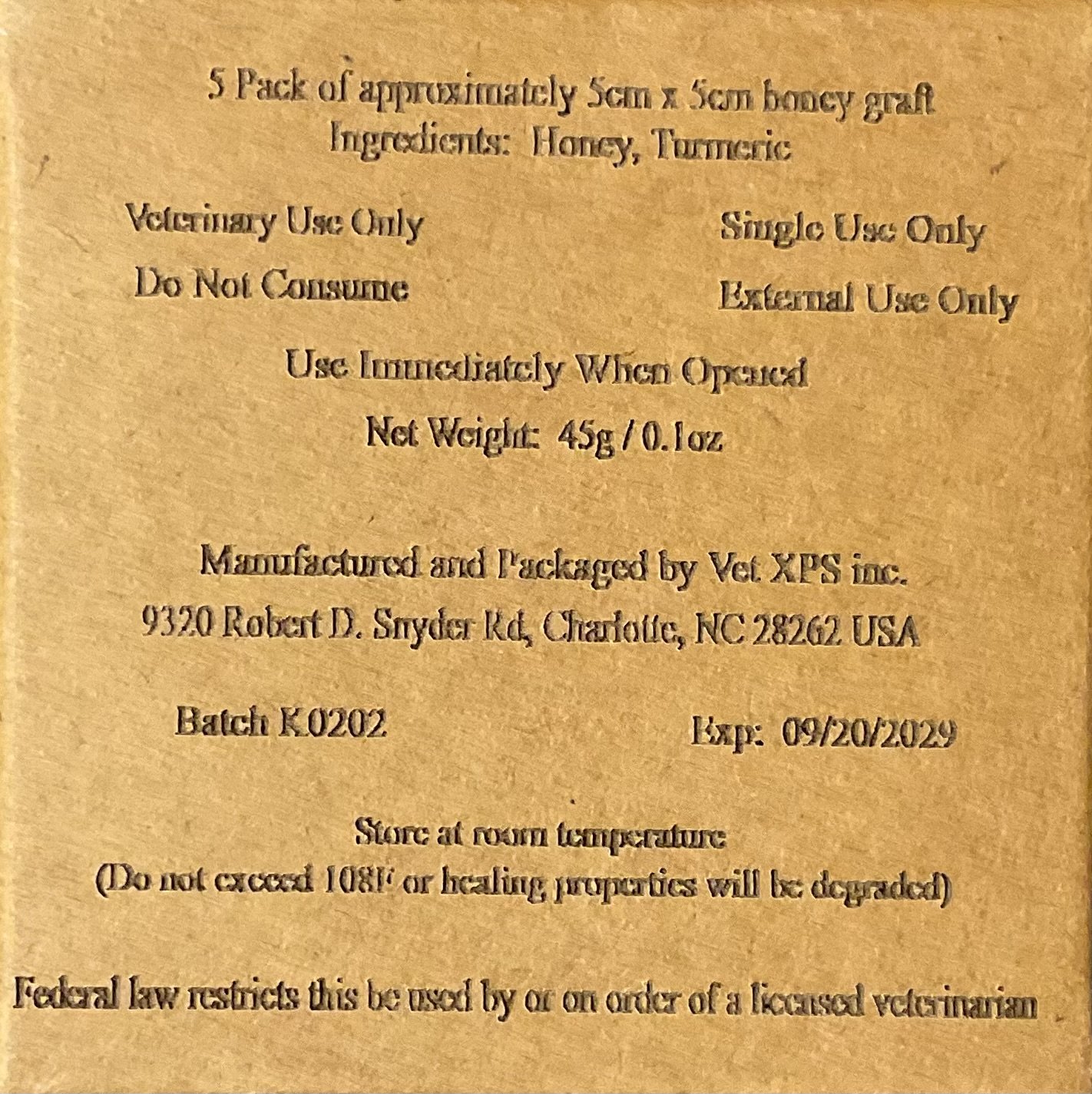

VetiHoney Graft, VetiHoney Gel, CyclaGraft, CyclaCanis, CyclaFelis, CyclaEqui Terms & Conditions
When “No Upfront Payment Needed. We get paid when you get paid.” it is referring to signing a contract for provider to pay the full amount due within 30 days of the shipment leaving the manufacturing facility. This payment deadline of 30 days is not contingent upon the provider being paid by the owner of the animal directly but is assumed that within a 30 day period the provider will have ample opportunity to use the product and collect payment on one of such opportunities. The shelf life is estimated to be greater than 5,000 years but we have chosen 6 years to provide extra safety buffer for our medical products. Research will be done to confirm this as well as the graft effectiveness. At this time any claim made on this webpage, in supplemental marketing material, or stated by a sales representative, distributor, or Dr. Scott Pless is not to be taken as certainty and will be enforced by commissioned research works. While we take appropriate measures to ensure VetiHoney products are sterile and safe for all animals, infection of wounds are very common and will occur even in the presence of the graft. We introduced the honey infused graft and VetiHoney which are both backed by extensive studies referencing the anti-microbial properties of honey being vastly superior to alternatives such as silver-sulfadiazine (SSD). We are not liable to any claimed infection that arises from a wound with VetiHoney is used on.
